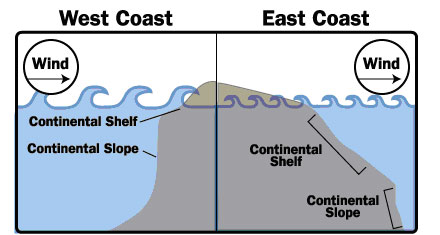 Section Warm-Up
Section Warm-Up
Motion and energy in the atmosphere create wind, which is the horizontal movement of air over Earth. Wind is used for recreation; it can be harnessed for energy production; and it is a cause of storm damage, which is sometimes severe. Wind also played an important role in history in making ocean trade and exploration possible.
Surfers know that waves are much larger on the west coast of the U.S. than on the east coast, which is why parts of California and Hawaii are more famous surfing areas than places along the east coast. This exploratory activity will help you visualize the effects of winds on water waves. Follow the procedure below:
- Get a shallow glass baking dish and fill it about three-fourths full with water.
- Mark one end of the dish as the shoreline.
- Find a hand-held hair dryer. Hold it over the middle of the shallow dish pointing toward the shoreline and turn it on. Write down your observations—pay close attention to what happens at the shoreline. Be careful with the hair dryer—if it falls into the water, DO NOT TOUCH THE WATER. Immediately unplug the hair dryer to remove the danger.
 Imagine that the water in the dish represents the ocean and that the marked end of the dish is the coast where surfers are out looking for giant waves. What happens to the waves when the wind blows directly over the water? What do you think would happen if the wind were blowing in the opposite direction the waves were forming?
Imagine that the water in the dish represents the ocean and that the marked end of the dish is the coast where surfers are out looking for giant waves. What happens to the waves when the wind blows directly over the water? What do you think would happen if the wind were blowing in the opposite direction the waves were forming?
Notice that at the west coast, the waves move in the same direction as the wind. The wind, like the air from the hair dryer, adds energy to the waves. The waves get larger as they build up at the shoreline. On the other hand, the wind moves in the opposite direction from the ocean waves on the East coast. So the energy is taken from the waves and they do not get as big.